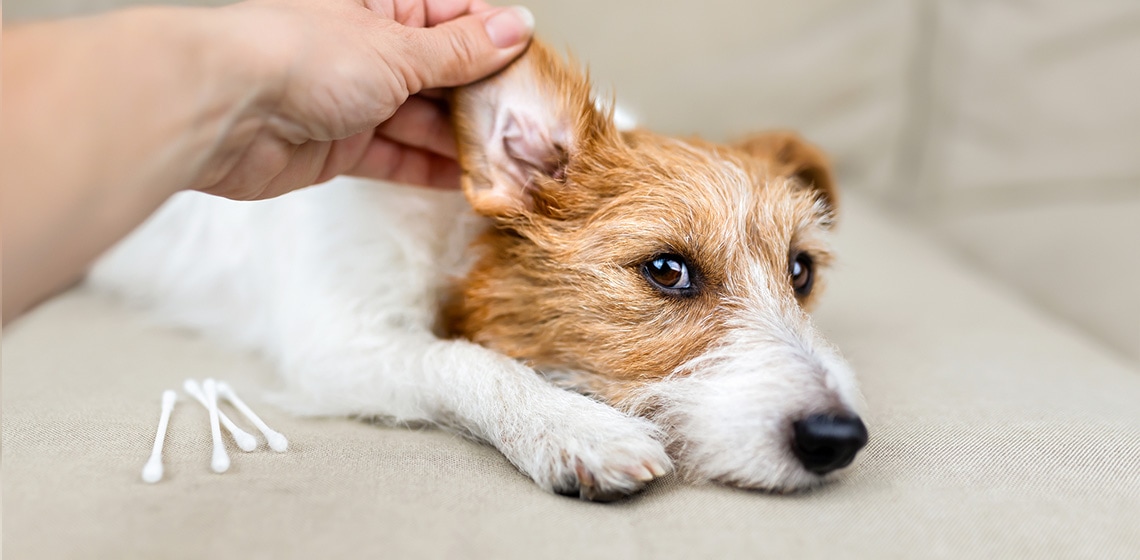Table of Contents
Causes of Otitis Externa
Parasites such as ear mites, demodex, fleas, and ticks are a common primary cause.1,2 Hypersensitivities are responsible for about 43% of cases.1 This can be due to environmental allergies, food allergies, or contact hypersensitivities. The third most common primary cause are foreign bodies. There are other, much less common causes of otitis that your veterinarian may investigate further.
Predisposing Factors
Factors that increase the risk of developing otitis can be internal or external. Internal factors include increased soft tissue in the ear canal, stenosis (narrowing) of the ear canal, and excessive hair in the canal. External factors include increased humidity and temperature of the environment, swimming, and bathing. These factors increase moisture in the ear canal which favors overgrowth of yeast and bacteria.3
Certain breeds are also predisposed to developing Otitis. These breeds include Cocker Spaniels, Springer Spaniel, Golden Retriever, and Labrador Retrievers.
Symptoms
The most common symptoms are scratching at the ear(s), head shaking, red/irritated ear pinna(s), or foul odor from the ear(s), and pain from the ear(s).
The Ear Exam
The first part of the ear exam includes your veterinarian looking into the ear canal with an otoscope. This will help look at the tympanic membrane (ear drum) for possible rupture. This is an important step as some medications should not be used if the tympanic membrane is not intact. This will also help look for foreign bodies and changes to the external ear canal.
The second part of the ear exam includes cytology of debris from the ear. This is a microscopic evaluation to look for an abnormal amount of bacteria or yeast, parasites, or evidence of inflammatory cells. This exam is important as it helps determine which medication would be most useful for treatment. Rods are a type of bacterium found in ear infections that often require stronger antibiotics and a specialized ear cleaner. This is due to rods having a cell wall that needs to get broken down for medication to penetrate the bacterium and kill it.
If ear infections have been a chronic issue, your vet may recommend culturing the debris. This can help determine which medications will be the most effective.
Treatment
Finding the underlying cause for targeted therapy is recommended.
Ear Cleaning- Removing debris from the ear canal is an important step for treatment as the debris can deactivate some topical treatments and prevent the medication from contacting the canal. Your veterinarian will recommend a cleaner that will be best to help treat. These products often have a drying agent to help reduce moisture in the ear canal. Cleanings should continue throughout treatment depending on the medication prescribed.
Topical Therapy – Steroids, antibiotics, and antifungals are indicated based off the infection type. These products are often found all together in combination products. Your veterinarian may apply a product that stays in the ear for a few weeks or have you apply the product once or twice daily for 2-4 weeks.
Complications
Ear infections can spread from the external canal to the middle (otitis media). This condition can cause signs such as a head tilt, ataxia (off-balance walking), decreased eating, pain on opening mouth. This condition usually needs systemic medications and may even need a sedated cleaning and sampling of the middle ear, called a myringotomy. Some veterinarians may also recommend advanced imaging including a CT scan or MRI to check for abnormalities of the middle ear.
Ear infections may also lead to aural hematomas. This is a pocket of blood that develops on the ear pinna that is caused by breaking of the small blood vessels of the ear. This condition can be fixed surgically or nonsurgically.
Monitoring
Frequent follow-ups are important for otitis with repeated cytology to make sure that the treatment doesn’t need to be modified. It is also important to monitor for deafness. This can be caused by cleaning the ears or certain antibiotic usage. Most of the time, the deafness is transient and comes back after stopping the medication.
1. Miller WH, Griffin CE, Campbell KL: Diseases of eyelids, claws, anal sacs, and ears. Muller and Kirk’s Small Animal Dermatology, 7th ed. Elsevier Mosby , St. Louis 2013 pp. 739-41
2. Hnilica KA: Otitis Externa. Small Animal Dermatology: A Color Atlas and Therapeutic Guide, 3rd ed. St. Louis, Elsevier Saunder 2011 pp. 395-398.
3. Gotthelf, LN: Diagnosis and Treatment of Otitis Externa and Otitis Media. ACVC 2010.
FAQ
Common symptoms of an ear infection are shaking of the head, scratching at the ears, hair loss around ears, brown/black debris in ears, foul smell
Treating a dog’s ear infection at home is not recommended as it’s challenging to determine if the eardrum is ruptured. Seek your veterinarian’s assessment of your dog’s ear and get their professional guidance on the most suitable cleaner for effective treatment.
Yes, your veterinarian needs to do an exam and find out if there is an underlying cause and help you with treatments.
To prevent your dog from getting ear infections, ensure you keep the ears dry and clean. Also, reducing any factors like allergies will help reduce ear infections.

Dr. Lindsey Parker graduated from the University of Tennessee in 2020. She has worked as a general practitioner and relief veterinarian in El Paso, Texas and Northen Virginia. Dr. Parker is passionate about preventative care and believes client education is the foundation for great care. Her husband’s military career has taken them all across the country. Dr. Parker likes to spend time with her husband, son, and two dogs.








